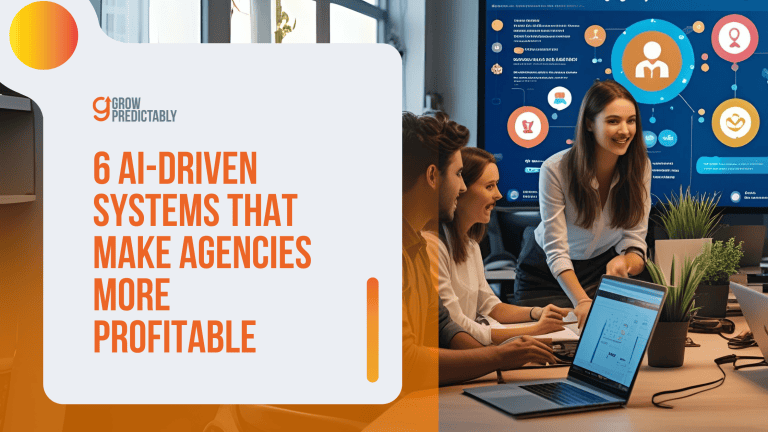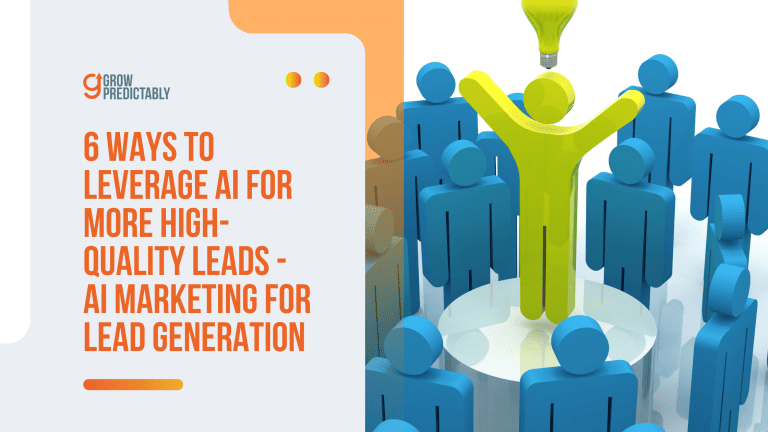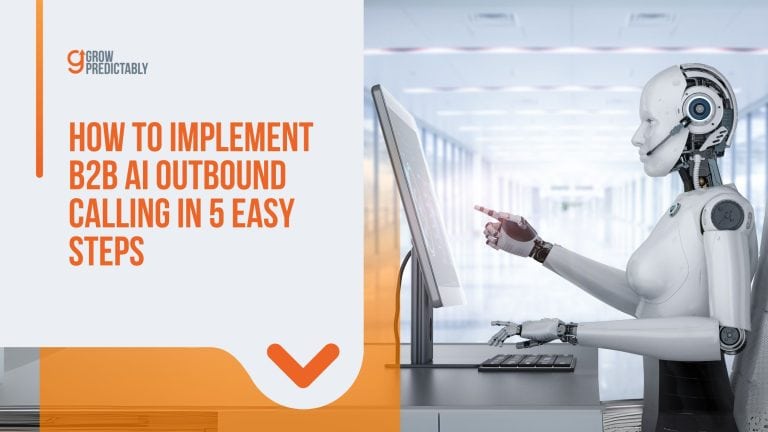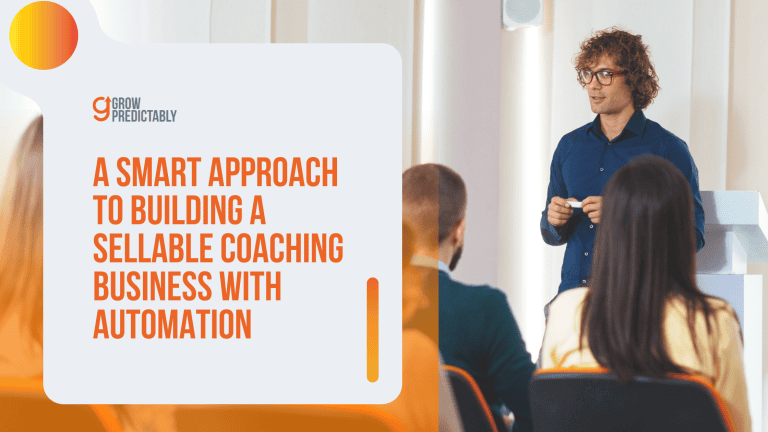AI for Coaching Business: 4 Proven Frameworks to Scale Growth & Engagement
You get what you focus on.
Most coaching businesses dump money into AI tools thinking they’ll magically grow their business.
They don’t.
The real problem?
They’re using AI like a hammer when they need a scalpel.
Every coaching business sits at a different stage of growth, serves different clients, and faces unique bottlenecks.
Cookie-cutter AI solutions ignore these realities completely.
Smart coaching businesses use proven frameworks to guide their AI integration.
By leveraging artificial intelligence, coaching businesses can implement cutting-edge solutions that drive growth, enhance client engagement, and stay ahead in a rapidly evolving industry.
When you map AI touchpoints to your actual client journey and tie every investment to measurable outcomes, you get predictable results instead of expensive tech toys.
This framework-driven approach reveals exactly where AI creates the biggest impact in your coaching business.
You’ll discover how to eliminate hidden bottlenecks that kill conversions, craft messages that actually resonate with your ideal clients, and deliver personalized experiences that keep people engaged.
TL;DR
Leveraging AI in high-ticket coaching enhances personalization, automates routine tasks, and optimizes client engagement through structured frameworks. AI tools should align with the Customer Value Journey for maximum impact — from attracting prospects to turning them into advocates, thereby boosting growth and engagement.
KEY TAKEAWAYS
- Prioritize AI tools that directly address the stages in the Customer Value Journey to enhance personalization and client engagement.
- Analyze metrics to track client behavior and adjust strategies for better conversion rates and customer satisfaction.
- Focus on building a strategic AI implementation roadmap that aligns with business growth objectives, beginning with small, high-impact steps.
Table of Contents
What Role Does AI Serve in the Coaching/Consulting Sector?
The coaching industry hit a turning point in 2024.
The coaching industry boasts an estimated market size of approximately $5.34 billion, a figure expected to ascend to around $6.25 billion in 2024.
While everyone talks about growth, the real story is what’s driving it.
AI isn’t just changing how coaches work – it’s redefining what’s possible when you serve clients at scale.

Life coaches and human coaches are adapting to these AI-driven changes, but the unique empathy, intuition, and personal connection that human coaches provide remain essential for effective coaching.
Here’s what most people get wrong about AI in coaching.
They think it’s about replacing human connection or automating everything.
That’s backwards. AI amplifies your ability to deliver personalized value to more people without burning out.
When you use AI to handle routine tasks, you spend more time on what actually moves the needle – strategic guidance, breakthrough conversations, and deep client transformation.
The Real Impact of AI Integration
Smart coaches use AI like a force multiplier.
Instead of spending hours on administrative tasks, data analysis, or content creation, you focus on high-impact client work.
The numbers back this up: 72 percent of companies are integrating AI into at least one business function, representing a substantial leap from 55 percent in the previous year.
The coaching businesses that ignore this shift will find themselves competing with one hand tied behind their back.
Real-time personalization becomes possible when AI handles the heavy lifting.
Your clients get customized feedback, tailored action plans, and precisely timed interventions based on their actual behavior patterns.
This isn’t about being fancy – it’s about being effective.
When you can deliver the right message to the right person at the right moment, client results improve dramatically.
This level of personalization creates a superior coaching experience for both clients and coaches, making every interaction more seamless and impactful.
Navigation Challenges and Strategic Solutions
Most coaching businesses approach AI like they’re trying to boil the ocean.
They want to implement everything at once, then wonder why nothing works properly.
Here’s the truth: successful AI integration requires systematic thinking and careful planning.
Common pitfalls include:
- Choosing tools without understanding your specific bottlenecks
- Implementing AI without proper data governance or client consent protocols
- Neglecting data protection standards and certifications, which are essential for maintaining client trust and legal compliance.
- Expecting immediate results without investing in proper training and setup
- Focusing on automation instead of augmentation
The businesses that win with AI treat it as part of a larger growth system.
They map AI capabilities to specific stages of their client journey.
They measure results obsessively.
They prioritize ethical data use and maintain complete transparency with clients about how AI enhances their experience.
Framework-Driven Implementation
Random AI experiments waste money and time.
Systematic AI integration using proven frameworks like the Customer Value Journey and Growth Triad creates predictable results.
When you align AI investments with your core business metrics, every dollar spent moves you closer to your growth goals.
The coaching businesses that will dominate the next decade aren’t the ones with the most AI tools.
They’re the ones with the clearest strategy for using AI to deliver better client outcomes while building sustainable, scalable operations.
These businesses leverage AI frameworks to maximize impact and efficiency, allowing them to enhance their services and gain a competitive edge.
This requires treating AI as your North Star for systematic growth, not just a shiny object to play with on weekends.
How to Structure an AI Implementation Path with The Customer Value Journey (CVJ)
The Customer Value Journey gives coaching businesses a proven eight-stage blueprint for AI integration that actually works.
This approach also supports organizational development by aligning AI initiatives with business growth objectives.
Instead of throwing technology at random problems, this framework shows you exactly where AI creates the biggest impact on client relationships and revenue.
Every stage has specific opportunities to use AI strategically, not just for automation’s sake.
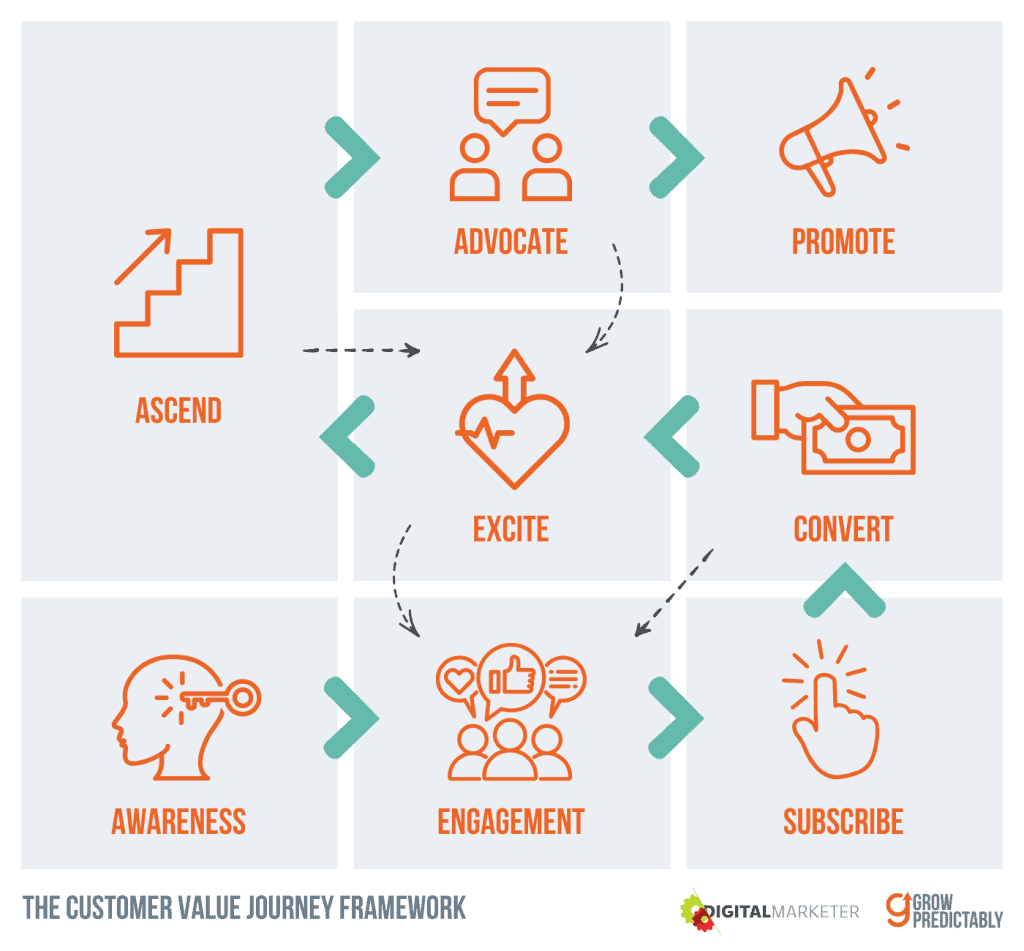
Most coaching businesses waste money on AI tools because they don’t understand their client journey.
They buy shiny software without knowing where clients get stuck, what causes them to quit, or which moments drive the biggest transformations.
The Customer Value Journey fixes this by mapping AI touchpoints to real client psychology and behavior patterns.
Awareness: Expanding Reach Through AI-Enhanced Discovery
Your potential clients can’t buy from you if they don’t know you exist.
AI transforms how people discover your coaching services by eliminating the guesswork from audience targeting and content distribution.
AI can also optimize content distribution across multiple platforms, ensuring your message reaches the widest and most relevant audience possible.
Instead of hoping your message reaches the right people, you know it will.
AI-powered content recommendation engines analyze user behavior to deliver personalized introductory content that resonates with each prospect’s specific situation.
This creates meaningful first impressions instead of generic marketing that gets ignored.
The key is using AI to identify micro-signals that indicate someone is ready for coaching, then serving them exactly the right content at the right moment.
Healthcare coaching businesses have used AI-driven content distribution to identify and target specific patient populations with specialized wellness programs.
This targeted approach resulted in 40% higher engagement rates than traditional marketing methods.
The difference comes from relevance – when people see content that speaks directly to their situation, they pay attention.
Engagement: Building Interest with Intelligent Interactions
Discovery is worthless if people don’t stick around long enough to understand your value.
AI deepens engagement through tailored interactions that feel personal but scale across hundreds or thousands of prospects.
This stage determines whether someone becomes a committed prospect or just another website visitor.
Conversational AI chatbots trained on your coaching methodology provide valuable insights and answer common questions instantly.
AI-powered coaching tools, such as customizable chatbots and assessment platforms, play a crucial role in deepening engagement and scaling personalized interactions for coaching practices.
These systems analyze user responses to gauge interest levels and tailor follow-up accordingly.
The magic happens when your chatbot delivers the same quality of interaction you would provide personally, but to unlimited people simultaneously.
Education-focused coaching businesses have seen a 35% increase in prospect interaction time by deploying AI chatbots trained on their curriculum and teaching philosophy.
The chatbots don’t replace human connection – they create more opportunities for it by handling routine questions and qualifying serious prospects.
Financial coaching businesses use AI-powered financial assessment tools to provide immediate, personalized insights that demonstrate value before asking for any commitment.
This approach builds trust and creates what experts call “the business equivalent of eye contact” – that moment when prospects realize you understand their specific challenges.
Subscribe: Converting Interest into Commitment
The subscribe stage represents the first micro-commitment where prospects trade their contact information for value.
AI significantly improves conversion rates by personalizing the value proposition for each individual prospect based on their demonstrated interests and behavior patterns.
Smart coaching businesses develop AI recommendation engines that suggest the most relevant lead magnets based on behavioral analysis.
AI can also streamline the process for prospects to schedule initial consultations or coaching sessions, making it easy for users to book appointments at convenient times.
Instead of offering the same generic download to everyone, the system presents exactly what each prospect needs most.
This increases subscription rates by addressing specific pain points rather than hoping a one-size-fits-all approach works.
Personalized emails have a 29% higher open rate and a 41% higher click-through rate compared to non-personalized emails.
The same principle applies to lead magnets – personalized offers consistently outperform generic ones.
Legal coaching businesses have implemented AI-powered assessments that identify specific compliance vulnerabilities, automatically generating tailored reports that prospects receive upon subscription.
This approach increased opt-in rates by 27% compared to generic lead magnets because prospects receive immediate, actionable value specific to their situation.
Convert: Facilitating Initial Purchases with AI Guidance
The convert stage is where interest transforms into revenue.
AI reduces friction and increases confidence by addressing the specific concerns that prevent people from making their first purchase.
This isn’t about manipulation – it’s about removing legitimate barriers that keep qualified prospects from getting help.
AI-driven solutions are designed to scale your coaching business without compromising quality, ensuring that high standards and service integrity are maintained as you grow.
AI-driven pricing algorithms offer personalized payment plans or package recommendations based on individual prospect data.
This addresses budget concerns while maximizing conversion probability.
The system considers factors like engagement level, demonstrated urgency, and financial capacity to suggest the most appropriate starting point.
Consumer behavior coaching programs use AI to analyze prospect interactions and automatically offer tailored mini-sessions addressing specific pain points.
This approach achieved 42% higher conversion rates than standard offerings because prospects see immediate relevance to their situation.
B2B coaching contexts benefit from AI systems that generate customized ROI projections based on prospect-specific data.
Instead of generic business cases, prospects see exactly how coaching will impact their specific metrics, making the investment decision much clearer.
Excite: Delivering Transformative “Aha” Moments
The excite stage determines whether new clients become long-term success stories or early dropouts.
AI dramatically enhances the post-purchase experience by delivering immediate value that validates the client’s decision to invest in coaching.
These AI-driven quick wins directly support clients’ personal development journeys by fostering growth, empowerment, and self-discovery from the very beginning.
This stage sets the tone for everything that follows.
AI systems analyze client inputs to identify quick wins and automatically generate personalized action plans within 24 hours of sign-up.
This immediate response creates momentum and demonstrates that the coaching relationship will be proactive, not reactive.
Clients feel seen and understood from day one.
Key excite stage implementations include:
- Automated onboarding sequences that adapt based on client responses
- AI-generated quick win recommendations specific to each client’s situation
- Personalized milestone tracking that celebrates progress others might miss
- Intelligent content delivery that matches each client’s learning style
Healthcare coaching businesses have implemented AI that analyzes client health metrics to create personalized achievement milestones, celebrating small wins that might otherwise go unnoticed.
This approach increased program completion rates by 32% because clients feel continuous progress rather than waiting for major breakthroughs.
Ascend: Scaling Value Through AI-Enhanced Experiences
The ascend stage is where clients become ready for deeper engagement and higher-value offerings.
AI identifies the perfect moment for these transitions by analyzing engagement patterns, progress metrics, and behavioral signals.
It can also pinpoint existing clients who are most likely to benefit from advanced programs or services, ensuring targeted upsell opportunities.
This prevents the awkwardness of premature upsells while ensuring you don’t miss opportunities.
AI systems track multiple data points to determine upsell readiness: completion rates, engagement frequency, goal achievement, and satisfaction scores.
When these indicators align, the system automatically triggers personalized upsell recommendations at moments of peak satisfaction.
This feels natural to clients because the timing is based on their actual progress, not arbitrary sales calendars.
AI-driven product recommendations can boost conversion rates by 915% and average order values by 3%.
The key is timing and relevance – offering the right upgrade at the moment when clients are most ready to invest further.
Executive coaching businesses have used AI to analyze client progress data and automatically generate personalized “next level” coaching proposals.
This approach increased upsell acceptance rates by 45% compared to standardized timing because proposals arrive when clients are experiencing success and wanting more.
Advocate & Promote: Amplifying Success Stories Systematically
The final stages transform satisfied clients into vocal advocates and active promoters.
AI helps identify clients achieving exceptional results and automates the process of capturing and sharing their success stories.
This creates a systematic referral engine that grows your business through authentic testimonials.
AI systems monitor client progress indicators to identify success stories as they happen, not months later when details are forgotten.
The system automatically generates case study drafts and testimonial requests at opportune moments when clients are experiencing peak satisfaction with their results.
Effective advocate stage implementations include:
- Automated success story identification based on progress metrics
- AI-generated testimonial and case study requests timed to peak satisfaction
- Referral program tracking that rewards advocacy behaviors
- Social proof automation that highlights client wins across marketing channels
- Automated generation and distribution of social media posts that showcase client success stories and testimonials
Corporate training coaches have used AI to identify high-performing client teams and automatically generate shareable impact reports.
When these teams shared their success stories, it resulted in a 67% increase in referral rates.
The system creates a continuous loop where success breeds more success through systematic amplification.
Make AI Integration More Data-Driven with The Growth Triad
Most coaching businesses buy AI tools because they sound impressive or because competitors are using them.
This backwards approach leads to expensive software subscriptions that don’t move the needle.
The Growth Triad prevents coaching businesses from wasting money on random AI tools by focusing on three essential assets: Documented Customer Journey, Actionable Metrics, and Strategic Tools & Tactics.
Yes, data can significantly improve AI integration in your business by focusing on a strategic approach. Start by mapping your customer journey to identify specific friction points. Track actionable metrics that connect directly to revenue and client success, avoiding vanity measures. Choose AI tools that target your business bottlenecks rather than buying into industry trends. This method turns AI into a reliable growth driver, rather than an expensive experiment.
The Growth Triad forces you to understand your actual bottlenecks before spending a dollar on technology.
Documented Customer Journey: Mapping AI Touchpoints to Client Experiences
Your client journey documentation becomes the foundation for strategic AI integration.
Without detailed mapping of how people move from awareness to advocacy, you’re guessing about where AI creates the biggest impact.
This isn’t about pretty diagrams – it’s about understanding exactly where clients get stuck, confused, or excited.
Start by mapping your client journey with explicit documentation of actions, progression triggers, and conversion rates at each stage.
AI can also assist in tracking client goal setting and progress, ensuring that personalized objectives are established and monitored throughout each phase.
Involve every team member who touches clients in this process.
The goal is identifying precise moments where AI can remove friction or amplify success.
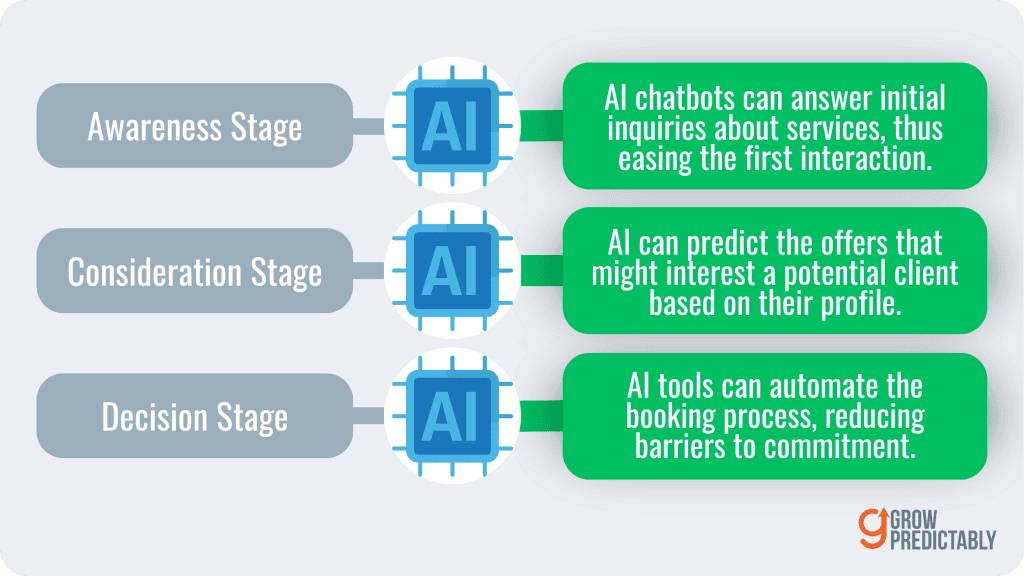
For B2B SaaS businesses, drop-off rates between 97.7% and 99.1% are common from initial website visit to signup.
This means most coaching businesses have massive leaks in their funnel that AI can help seal.
The key is knowing where these leaks occur in your specific business.
A leadership coaching firm discovered their intake assessment process was causing a 42% drop-off rate.
They implemented AI automation that reduced this to just 9% by making the process more intuitive and providing immediate value.
The difference came from understanding the specific friction point before choosing the solution.
Retail coaching contexts revealed that post-purchase follow-up was occurring too late, creating a 3-day window where clients felt uncertain about their investment.
AI-triggered communication protocols closed this gap, increasing program retention by 27%.
The insight came from detailed journey mapping, not random automation.
Actionable Metrics: Measuring What Matters for AI-Driven Growth
The Growth Scorecard component ensures AI investments focus on measurable improvements rather than vanity metrics.
Most coaching businesses track the wrong numbers, then wonder why their AI tools don’t improve business results.
You need metrics that directly connect to revenue and client success.
Implement a comprehensive Growth Scorecard that tracks three key metrics per journey stage: volume metrics (quantity), quality metrics (relevance), and efficiency metrics (resources required).
For each metric, establish red/yellow/green status levels and review weekly to identify constraints requiring immediate attention.
Fast-growing organizations drive 40% more revenue from personalization than their slower-moving counterparts.
The difference isn’t the tools they use – it’s the metrics they track and optimize.
Smart coaching businesses focus on metrics that predict long-term success, not short-term activity.
Tracking skill development is a critical metric, as it directly reflects how AI coaching supports workforce productivity and enhances employee capabilities.
This systematic approach helped an education coaching business discover that while their AI chatbot was handling high volumes of initial inquiries (green volume metric), the quality of leads was deteriorating (red quality metric).
They retrained the AI with better qualification parameters, resulting in 32% fewer but 51% higher-converting leads.
Financial coaching firms have implemented weekly tracking of client engagement metrics, revealing precisely which AI-generated content topics drove the highest completion rates.
This allowed for rapid optimization, increasing client implementation rates by 38% in just six weeks.
The key was measuring what actually mattered for client success.
Effective Growth Scorecard implementations include:
- Volume metrics that track quantity without sacrificing quality
- Quality metrics that measure relevance and client satisfaction
- Efficiency metrics that monitor resource allocation and ROI
- Weekly reviews that identify constraints before they become crises
Strategic Tools & Tactics: Selecting and Implementing AI That Delivers Results
This component ensures coaching businesses select and implement AI tools based on documented journey gaps and metric insights, not industry hype or competitor activity.
It is crucial to choose a reliable ai tool that aligns with your business needs and prioritizes client data safety to build trust and transparency.
The biggest mistake is trying to implement everything at once instead of focusing on your specific bottlenecks.
Prioritize AI implementations that directly address red metrics from your Growth Scorecard.
Limit active implementations to two at a time to prevent “half-built bridge syndrome” where nothing gets fully optimized.
This focused approach delivers better results than scattered efforts across multiple tools.
The AI-based personalization market is expected to reach $639.73 billion by 2029, but success comes from strategic implementation, not just market participation.
Companies that excel at AI personalization see measurable improvements in conversion rates, customer satisfaction, and revenue growth.
A wellness coaching business identified that client onboarding was their major constraint and implemented an AI-driven personalization system that automatically tailored first-week activities to client profiles.
By focusing solely on this implementation before moving to other AI projects, they achieved a 47% increase in program continuation rates.
Executive coaching practices have used this principle to develop AI-powered progress tracking tools that address the specific metric of “implementation rate” of coaching recommendations.
This targeted approach resulted in 35% higher client-reported value and a 29% increase in contract renewals.
Strategic implementation follows these principles:
- Address red metrics first, regardless of what’s trendy
- Complete one implementation fully before starting another
- Measure results obsessively and adjust quickly
- Scale successful implementations before adding new tools
The Growth Triad framework transforms AI from an expensive experiment into a systematic growth driver.
When you document your actual client journey, measure what matters, and implement tools strategically, AI becomes a predictable asset that grows your coaching business consistently.
If you’re ready to supercharge your coaching service with AI and the right frameworks, let’s build your AI growth roadmap.
Core Message Canvas: Crafting AI-Enhanced Communication That Resonates
The Core Message Canvas transforms how coaching businesses communicate by focusing on transformational messages that AI can personalize at scale.
This framework ensures automated communications maintain emotional resonance instead of sounding like generic marketing robots.
Most coaching businesses fail with AI-generated content because they feed the system vague instructions and expect magic.
AI can support coaches in writing compelling, transformation-focused content by assisting with the creation and improvement of website copy, blog posts, and coaching materials, but it needs clear direction to be effective.
They get boring, generic messages that clients ignore.
The Core Message Canvas fixes this by giving AI systems specific transformation-focused parameters that create compelling, personalized communication every time.
Before and After Grid: Visualizing Client Transformation for AI Content Creation
Your transformation documentation becomes the foundation for AI content that actually moves people.
Without clear before and after states, AI systems generate generic motivational fluff that nobody cares about.
This component creates structured transformation maps that give AI systems precise parameters for compelling content creation.
High-quality written content is essential for clearly communicating the client’s transformation and ensuring your message resonates.
Develop comprehensive Before and After grids for each client avatar that document specific changes across five dimensions: Have, Feel, Average Day, Status, and Good vs. Evil.
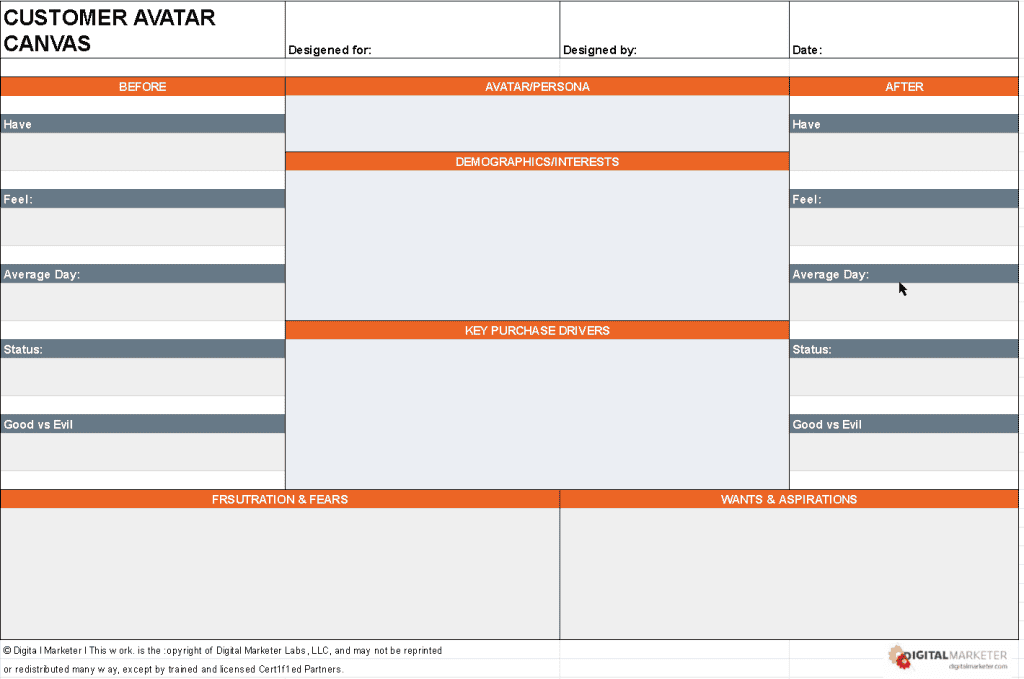
This isn’t about creating pretty charts – it’s about capturing the emotional and practical reality of transformation that your coaching delivers.
Personalized emails achieve an impressive open rate of 29% and an outstanding click-through rate of 41% compared to generic messaging.
The difference comes from relevance – when people see content that speaks to their specific situation and desired transformation, they pay attention.
Executive coaching businesses have used this approach to create AI content generators that consistently produce messaging focused on the transformation from “overwhelmed and reactive” to “strategic and confident.”
This targeted approach resulted in a 43% increase in message response rates because the content addresses real pain points and desired outcomes.
Relationship coaches have trained AI systems on detailed Before and After grids to automatically generate scenario-specific emails that address client concerns with empathy and insight.
This systematic approach increased open rates by 37% and click-through rates by 42% by delivering content that feels personally relevant rather than mass-produced.
Statement of Value: Creating Clear AI-Deliverable Value Propositions
This component distills complex coaching benefits into clear, concise statements using the proven formula: “[Product/Service] helps [Customer Avatar] achieve [After State].”
This clarity becomes essential for effective AI-generated messaging that converts prospects into clients.
Develop distinct value statements for each coaching program and client avatar combination, then use these to train AI communication systems.
These value statements enable AI to deliver personalized guidance tailored to each client’s unique needs, ensuring that automated support feels relevant and customized.
This ensures automated messages remain focused on the core value your coaching delivers instead of wandering into generic business speak that confuses people.
Career coaching businesses have used this approach to develop AI chatbots and email systems that consistently articulate how their programs help mid-career professionals transition to higher-paying roles.
This focused messaging increased initial consultation bookings by 38% because prospects immediately understood the specific value being offered.
Wellness coaching businesses have created value statements focusing on specific health transformations to guide AI-generated content that consistently connects services to client aspirations.
This approach improved engagement rates by 27% across automated communication channels by maintaining message clarity and relevance.
Jobs to Be Done: Aligning AI Systems with Client Motivations
This framework component identifies the specific “jobs” clients are hiring your coaching to accomplish using the formula: “When I [situation], I want to [motivation], so I can [expected outcome].”
This insight becomes invaluable for AI personalization that hits the mark every time.
Create comprehensive Jobs to Be Done statements for each coaching service and use these to train AI recommendation and communication systems.
By asking specific questions in your prompts, you guide the AI to generate more relevant and personalized responses for each client.
This enables automated tools to align messaging with client motivations at each journey stage instead of sending random content that misses the mark.
SMS has a substantial 45% response rate on average, but only when the message addresses what people actually care about.
The Jobs to Be Done framework ensures your AI-generated communications speak directly to client motivations and desired outcomes.
Financial coaching businesses have used this insight to develop AI content systems that recognize when prospects are in specific financial situations (home purchase, career transition, retirement planning) and automatically adjust messaging to address the relevant motivations and outcomes.
This targeted approach increased conversion rates by 45% by speaking directly to what clients need most.
Leadership coaching AI systems trained on Jobs to Be Done analysis have generated targeted content for executives seeking to improve team performance, addressing their specific motivations rather than generic leadership topics.
This focused approach increased engagement by 51% because the content directly addresses what executives are trying to accomplish.
Metaphor and Analogy Development: Making AI Communications Relatable
This component helps simplify complex coaching concepts through relatable metaphors and analogies that AI can incorporate into automated communications.
Complex ideas become accessible when explained through familiar comparisons that people immediately understand.
Develop a library of powerful metaphors and analogies for each coaching concept, organized by client avatar and journey stage, and integrate these into AI content generation systems.
For example, using a metaphor like “navigating a maze” can help clients relate to the process of overcoming obstacles in their coaching journey, making the concept more tangible and easier to grasp.
This ensures automated communications remain accessible and emotionally resonant instead of sounding like academic textbooks.
64% of consumers want brands to connect with them authentically on social media, and metaphors create that authentic connection by making abstract concepts concrete and relatable.
The key is consistency – using the same metaphors repeatedly until they become part of your brand language.
Productivity coaches have trained AI systems to explain complex time management methodologies through consistent metaphors like “time as currency.”
This approach made follow-up emails and resources more engaging and actionable, resulting in a 34% increase in program implementation rates because clients could easily grasp and apply the concepts.
Spiritual coaching businesses have implemented AI systems incorporating carefully selected metaphors to automatically generate content that explains abstract concepts in accessible terms.
This systematic approach increased client comprehension and satisfaction by 29% by making complex spiritual concepts immediately understandable.
Effective metaphor libraries include:
- Core concept metaphors that explain your methodology simply
- Journey metaphors that help clients understand their transformation process
- Challenge metaphors that reframe obstacles as opportunities
- Success metaphors that make achievements feel attainable
The Core Message Canvas ensures your AI-generated communications maintain the emotional impact and clarity that drives client action.
When you systematically document transformations, clarify value propositions, understand client motivations, and develop consistent metaphors, AI becomes a powerful tool for scaling authentic, compelling communication.
AI Coaching + Ideal Client Profiles = Improved Personalized Experiences
Your coaching business dies when you try to help everyone.
The coaches who win big understand this truth: specificity creates profitability.
Ideal client profiles make AI coaching highly personalized by ensuring every interaction is tailored to resonate with prospects’ specific needs and motivations. By documenting aspects like demographics, past actions, and transformation journeys, AI systems can predict client readiness, craft compelling narratives, and fine-tune messaging to align with key purchase drivers. This precision targeting not only enhances client engagement but significantly boosts conversion rates, making your coaching business thrive with focused effectiveness.
The Ideal Client Profile framework turns your AI systems into precision weapons that target, engage, and convert your most valuable prospects.
When you document exactly who your best clients are, your AI stops wasting time on tire-kickers and starts delivering experiences that make people pull out their credit cards.
Demographics and Interests: Targeting AI Systems to Ideal Clients
Generic targeting is the enemy of exceptional results.
Your ideal clients have specific traits that separate them from the masses of people who will never buy from you.
Smart coaching businesses dig deep into these characteristics and feed this intelligence directly into their AI systems.
The difference between a coach making $50K and one making $500K often comes down to how precisely they can identify and target their perfect client.
Most coaches make the mistake of focusing on surface-level demographics like age and income.
The real money comes from understanding the distinctive traits that make your ideal clients different.
Document everything:
- Geographic location and lifestyle preferences
- Industry background and professional challenges
- Communication styles and preferred content formats
- Technology adoption patterns and platform usage
- Personal values and decision-making triggers
- Personality traits and behavioral tendencies that influence coaching engagement and outcomes
Leadership coaching businesses that implemented this targeted approach saw their AI-driven content recommendation engines deliver 47% higher engagement rates.
These systems specifically identified senior executives with particular industry backgrounds and leadership challenges, then served them hyper-relevant content that felt personally crafted.
Relationship coaching firms took a similar approach, creating AI marketing systems that zeroed in on couples with specific relationship durations and communication challenge profiles, resulting in 39% higher conversion rates on initial consultations.
Previous Actions and Purchases: Predicting Client Readiness with AI
People’s past behavior predicts their future decisions with scary accuracy.
Your best prospects leave digital breadcrumbs that signal their readiness to invest in coaching.
The coaching businesses that dominate their markets have AI systems that track these signals and automatically identify who’s ready to buy right now versus who needs more nurturing.
Smart coaches analyze the specific previous actions and purchases that correlate with coaching program success.
By reviewing client materials from past engagements—such as uploaded resources, completed assessments, and shared documents—AI systems can better predict readiness and personalize outreach.
This data becomes the foundation for AI lead scoring and nurturing systems that automatically separate hot prospects from cold ones.
You stop wasting time on people who aren’t ready and focus your energy on those who are primed to say yes.
Financial coaching businesses that implemented AI lead scoring systems analyzed prospects’ previous investments in educational resources, online courses, and financial tools to predict coaching readiness.
The result? A 53% increase in qualification rates because they stopped chasing people who weren’t serious about change.
Health and wellness coaches saw similar results when their AI systems analyzed fitness app usage, supplement purchases, and content consumption patterns.
These coaches improved conversion rates by 41% by automatically identifying prospects who were already taking action in their health journey.
Before and After State: Using AI to Communicate Transformation
People don’t buy coaching services.
They buy the transformation those services deliver.
Your AI systems need to understand the exact journey your clients take from their current frustrated state to their desired future state.
When your automated communications can paint this picture clearly, prospects start seeing themselves in the success stories instead of wondering if coaching actually works.
Document every aspect of your clients’ transformation journey.
Encourage both coaches and clients to take time to reflect on progress and transformation at each stage, as this self-assessment deepens understanding and highlights growth.
This includes their emotional state when they first contact you, the practical challenges they face, and the status changes they experience after working with you.
Your AI content generation systems use this information to create messaging that speaks directly to where prospects are right now and where they want to be.
Career coaching businesses that mastered this approach developed AI email systems that automatically generate client-specific success scenarios based on current career state and aspirations.
These personalized communications increased program applications by 36% because prospects could clearly see their path to success.
Executive coaching firms saw even better results when their AI content systems incorporated specific before/after transformations into personalized landing pages and follow-up communications.
By speaking directly to prospects’ current challenges and desired outcomes, these firms improved conversion rates by 45%.
Key Purchase Drivers: Aligning AI Messaging with Decision Factors
Every coaching purchase decision comes down to specific factors that either push prospects toward yes or pull them away from it.
According to HubSpot’s research, 90% of purchase decisions are influenced by emotional factors, but those emotions are triggered by very specific concerns and motivations.
Your AI systems need to understand these triggers and address them automatically in every interaction.
Document both the functional and emotional purchase drivers for each coaching service and client type.
This intelligence powers your AI messaging and sales support systems, ensuring every automated communication addresses the factors most likely to influence decisions.
You stop sending generic messages and start delivering precisely what each prospect needs to hear.
Leadership coaching businesses that implemented AI sales support tools analyzed prospect interactions to identify primary purchase motivators like career advancement, team performance, and stress reduction.
AI messaging can also be tailored to align with established leadership frameworks for organizational clients, ensuring communications reflect company values and leadership development strategies.
These systems automatically adjusted messaging to emphasize the most relevant benefits for each prospect, increasing close rates by 31%.
Relationship coaching firms trained their AI systems on key purchase drivers to generate personalized follow-up content addressing specific concerns about confidentiality, approach methodology, and success metrics.
This targeted approach resulted in a 42% increase in program enrollments because prospects got answers to their actual concerns instead of generic sales pitches.
Implementing a Framework-Driven AI Strategy for Coaching Businesses
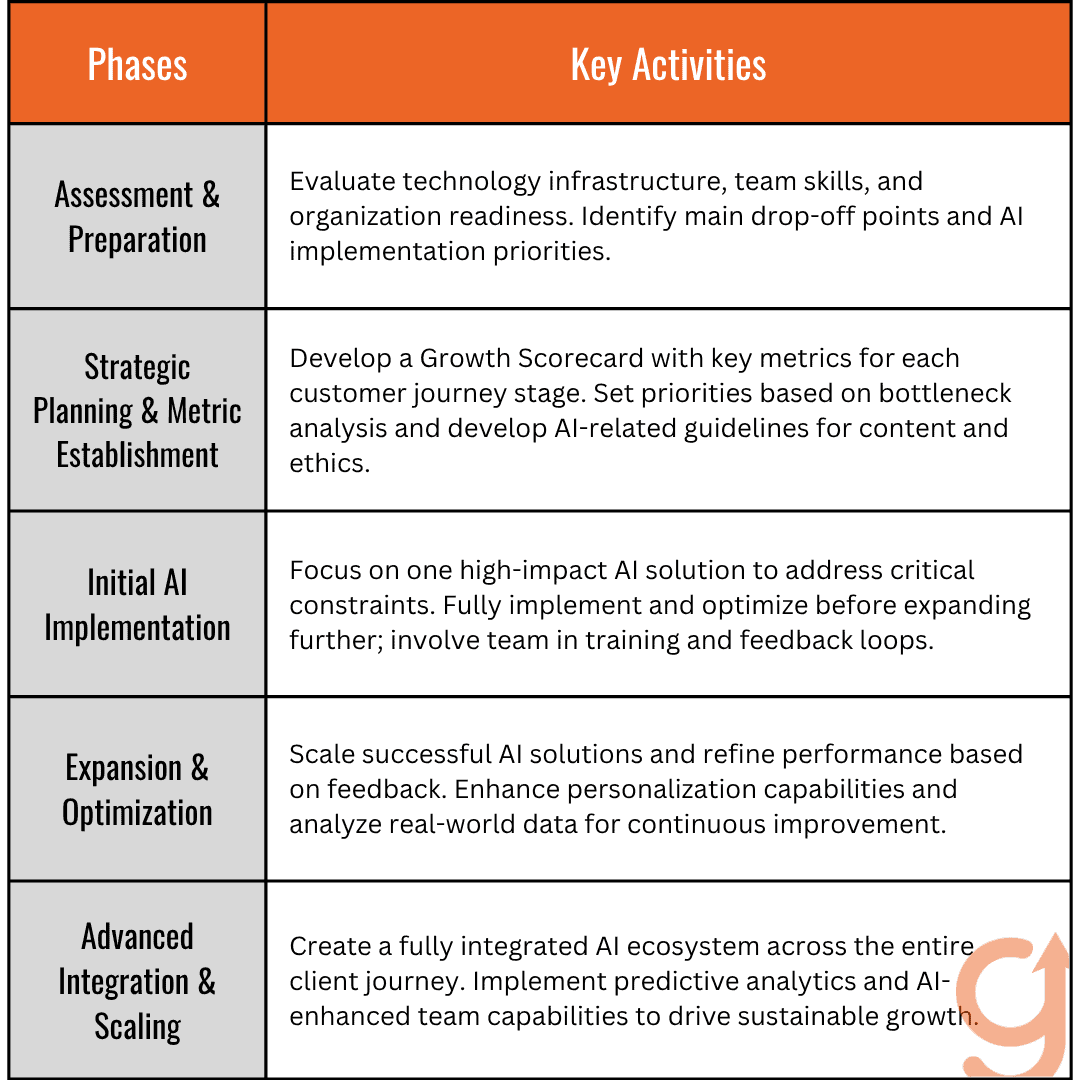
Most coaching businesses approach AI like they’re throwing spaghetti at a wall.
They buy expensive software, hope it works, and wonder why their revenue stays flat.
The coaches who actually make money with AI follow a systematic approach that aligns technology with business objectives and client needs.
This approach helps coaches save time by streamlining processes and reducing manual effort.
This implementation roadmap combines proven frameworks into a comprehensive strategy that turns AI from a shiny object into a profit machine.
Phase 1: Documentation and Assessment (Weeks 1-4)
You cannot improve what you cannot measure, and you cannot measure what you do not document.
Before you spend a single dollar on AI tools, you need to understand exactly how your coaching business operates right now.
This phase separates the professionals from the amateurs because it requires actual work instead of just buying software.
Your first step is mapping your complete client journey from initial awareness through long-term advocacy.
Document every touchpoint, conversion rate, and timeline for each stage.
Then interview actual clients to understand their experience and identify pain points you might be missing.
This isn’t busy work—it’s the foundation that determines whether your AI implementation succeeds or fails.
Next, create detailed client avatars and Ideal Client Profiles with specific demographics, behaviors, motivations, and transformation states.
Document what makes these clients uniquely valuable to your coaching practice.
The more specific you get, the more effectively your AI systems can target and serve them.
The final documentation task involves creating comprehensive before and after grids for each coaching service and client avatar.
Be sure to include educational materials in your documentation, as these resources are essential for enhancing AI training and supporting clients throughout their journey.
These grids capture the transformation clients experience across emotional, practical, and status dimensions.
Your AI systems will use this information to create compelling messaging that speaks directly to where prospects are now and where they want to be.
Complete this phase by conducting an AI readiness assessment that evaluates:
- Current technology infrastructure and data capabilities
- Team skills and training needs
- Organizational readiness for change
- Budget and resource allocation
- Potential integration challenges
An executive coaching firm that completed this phase thoroughly documented their client journey and created detailed ICPs for three distinct segments: C-suite executives, high-potential managers, and entrepreneurs.
This clarity revealed that their onboarding process was causing a 37% drop-off rate, immediately identifying their first AI implementation priority.
Phase 2: Strategic Planning and Metric Establishment (Weeks 5-8)
Strategy without measurement is just wishful thinking.
This phase establishes the metrics and planning framework that will guide your AI implementation decisions.
You need clear numbers that tell you whether your AI investments are working or wasting money.
Start by implementing a Growth Scorecard with 3-5 key metrics for each customer journey stage.
Set clear red, yellow, and green thresholds for each metric and begin weekly tracking to establish baselines.
This scorecard becomes your North Star for all AI implementation decisions.
Use your Growth Scorecard data to identify the 1-2 most significant bottlenecks in your coaching business.
Analyzing these metrics can reveal new insights that help you optimize your coaching business and uncover opportunities for improvement.
These constraints become your AI implementation priorities because fixing them delivers the biggest impact on your bottom line.
Don’t try to solve everything at once—focus creates results.
Create core messaging guidelines by developing Statements of Value and Jobs to Be Done statements for each coaching service.
These guidelines ensure your AI content generation stays on-brand and speaks directly to client needs.
Establish AI ethical guidelines that define clear principles for client data usage, transparency, and oversight.
A health coaching business used this approach to identify that client engagement between sessions was their major constraint, with program completion rates of just 62%.
They established metrics to track between-session engagement and implemented an AI accountability system that increased completion rates to 89% within two months.
Phase 3: Initial AI Implementation (Weeks 9-16)
This is where most coaching businesses either win big or crash and burn.
Success comes from focusing on one high-impact solution that addresses your most critical constraint.
Failure comes from trying to implement everything at once and doing nothing well.
Select and implement your first AI solution based on your constraint analysis from Phase 2.
For example, you might deploy an AI coach to provide personalized, on-demand support for clients, simulating coaching methodologies and scaling your services efficiently.
Choose something that directly addresses your biggest bottleneck with clear metrics for success.
Focus on full implementation and optimization before moving to additional solutions. Half-finished implementations deliver zero results.
Develop your team’s skills through comprehensive training on the AI system’s capabilities and limitations.
Your team needs to understand how to use the technology effectively and when human oversight is necessary.
Train them on troubleshooting common issues and interpreting AI-generated insights.
Create a transparent client communication plan that explains how AI enhances your coaching service.
Address potential concerns about automation while highlighting the benefits of personalized, data-driven support.
Clients who understand the value of your AI implementation become advocates for your business.
Establish feedback mechanisms to gather client and team input on AI performance.
This feedback drives continuous improvement and helps you identify issues before they become problems.
Regular feedback sessions also help your team feel involved in the implementation process.
A relationship coaching practice implemented an AI-powered content personalization system that automatically analyzed client assessment results and engagement patterns to deliver customized between-session resources.
This focused implementation increased client implementation rates by 47% and program completion rates by 34%.
Phase 4: Expansion and Optimization (Months 5-6)
With your first AI implementation stabilized and delivering results, you can begin expanding your capabilities.
This phase focuses on scaling what works while continuously refining performance based on real-world data.
Review your metrics and make necessary adjustments based on client and team feedback.
Analyze performance data from your initial AI implementation to identify optimization opportunities.
Document what’s working well and what needs improvement before moving to your next priority.
Implement your second priority AI solution with the same focused approach you used in Phase 3.
With experience from your first implementation, this process should be smoother and faster.
Apply lessons learned from your initial deployment to avoid common pitfalls.
Begin scaling your content creation capabilities using AI tools guided by your Core Message Canvas components.
This expansion allows you to create more personalized, relevant content without proportionally increasing your workload.
Focus on content that directly supports your client transformation journey.
Develop enhanced personalization capabilities through increasingly sophisticated AI analysis of behavioral data and progress metrics.
AI-driven content can also help clients practice and acquire new skills relevant to their goals, such as giving feedback, building confidence, and preparing for performance reviews.
According to Epsilon research, 80% of consumers are more likely to make a purchase when brands offer personalized experiences.
This personalization becomes a competitive advantage that’s difficult for competitors to replicate.
An executive coaching firm expanded their initial AI implementation by adding an AI-powered progress tracking system that automatically analyzed client session notes to identify implementation patterns and suggest personalized follow-up resources.
This addition increased client-reported value by 41% and renewal rates by 36%.
Phase 5: Advanced Integration and Scaling (Months 7-12)
The final phase creates a fully integrated AI ecosystem that enhances all aspects of your coaching business.
This is where you transition from using AI as a tool to having AI as a core competitive advantage that drives sustainable growth.
Integrate your previously separate AI implementations into a seamless experience throughout the entire customer value journey.
Clients should experience consistent, personalized support from their first interaction through long-term advocacy.
This integration eliminates friction and creates a premium experience that justifies higher prices.
Implement advanced analytics that provide predictive insights about client outcomes and business performance.
These systems help you identify which clients are most likely to succeed, which programs deliver the best results, and where to focus your business development efforts.
Predictive analytics transform your coaching business from reactive to proactive.
Create AI-enhanced team capabilities that allow your coaches to serve more clients with greater impact.
This doesn’t mean replacing human connection—it means augmenting human capabilities with data-driven insights and automated support systems.
Your coaches become more effective, not less important.
Establish continuous learning systems that enable ongoing AI improvement through automated learning from client interactions and outcomes.
These systems ensure your AI capabilities evolve with your business and continue delivering improved results over time.
A leadership coaching organization integrated their separate AI implementations into a comprehensive system that tracked client progress across multiple metrics, automatically delivered personalized resources, and provided coaches with AI-generated insights before each session.
This integrated approach increased coach productivity by 32%, client results by 47%, and business revenue by 68% over 18 months.
FAQs
Why Strategic AI Implementation Separates Winners from Losers
The coaching industry’s $6.25 billion transformation is separating smart operators from those who get left behind.
The frameworks we’ve covered—Customer Value Journey, Growth Triad, Core Message Canvas, and Ideal Client Profile—prevent expensive mistakes by giving you a systematic approach instead of throwing money at random AI tools.
This framework-driven approach delivers what random implementation cannot: identifying hidden bottlenecks before they kill growth, aligning AI tools with specific client milestones, and transforming AI from expensive overhead into a revenue driver.
Healthcare coaches, corporate trainers, and relationship experts using these frameworks are seeing massive improvements in acquisition, engagement, and retention while their competitors are still figuring out what AI actually does.
Your competitors will eventually figure out AI basics.
The question is whether you’ll be years ahead with sophisticated, integrated systems or scrambling to catch up.
The frameworks are proven, the technology is available, and the opportunity is massive.
The only variable left is how quickly you decide to act on it.



